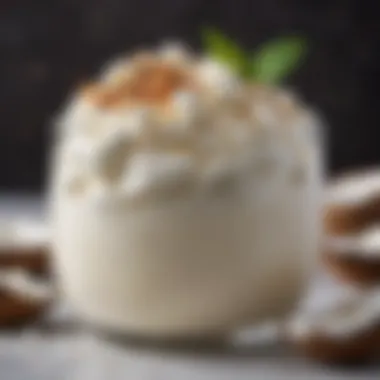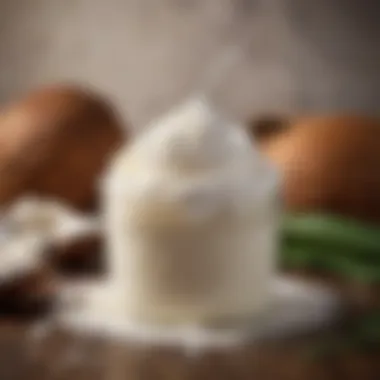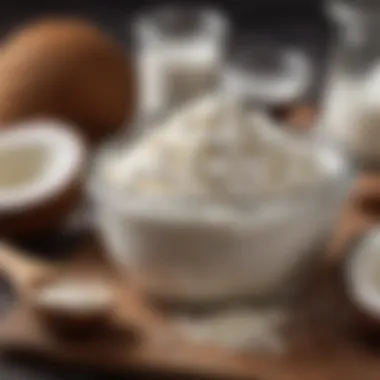Mastering Coconut Whipped Cream Storage and Use


Intro
Coconut whipped cream is a remarkable alternative to traditional whipped cream. It appeals to many, especially those adhering to vegan or dairy-free diets. This versatile ingredient can easily create a silky topping or a filling for various desserts. The depth of flavor from the coconut adds unique richness that can elevate many dishes, including cakes, ice creams, and fruit bowls. Furthermore, when stored correctly in an airtight container, coconut whipped cream can retain its fluffiness and freshness for an extended period.
This guide offers insights and techniques to master coconut whipped cream. You will learn a foundational recipe, discover effective storage practices, and explore creative ways to incorporate it into culinary creations. Whether you are a beginner or an experienced cook, this guide aims to enrich your cooking endeavors.
Recipe Highlight
Coconut Cloud Whipped Cream is the star of this section. This recipe delivers a delightful, airy topping perfect for various desserts.
Essential Ingredients
- 1 can (14 oz) full-fat coconut milk
- 2 tablespoons powdered sugar (or any sweetener of choice)
- 1 teaspoon vanilla extract
Estimated Time to Prepare
Prep time is approximately 15 minutes. However, refrigerating the coconut milk intensifies its texture before making.
Yield
This recipe generally yields about 2 cups of whipped coconut cream.
Step-by-Step Instructions
- Chill the Coconut Milk: Place the can of coconut milk in the refrigerator overnight. This step is crucial as it allows the cream to separate from the liquid.
- Open Carefully: The next day, without shaking the can, open it. Scoop out the thick cream that forms at the top, leaving the liquid behind for other recipes like smoothies.
- Combine Ingredients: In a mixing bowl, add the coconut cream, powdered sugar, and vanilla extract.
- Whip: Use an electric mixer to blend on medium speed until the mixture becomes airy and fluffy, about 3 to 5 minutes.
- Taste and Adjust Sweetness: You may adjust the sweetness by adding more powdered sugar if desired.
- Serve or Store: Use immediately or transfer to an airtight container for later use.
Cooking Techniques
Whipping requires the right technique. Be careful not to over-whip, as doing so can lead to a slightly grainy texture. Always use chilled equipment, including the bowl and beaters.
Insider Advice
One common mistake is using coconut milk that has not been properly chilled or using light coconut milk, which will not provide a thick texture.
Variations and Substitutions
To add some variety:
- Try using flavored extracts such as almond or coconut for enhanced taste.
- Instead of powdered sugar, one can use agave nectar for a lower glycemic option.
- For mocha whipped cream, add cocoa powder for decadent flavors.
You can also enjoy this whipped cream with:
- Fresh fruits such as strawberries or bananas.
- Pair it with chocolate cake for an indulgent treat.
Time-Saving Cooking Tips
- Prep Ahead: Keep chilled coconut milk in the refrigerator so you’re ready whenever you want to whip some up.
- Use a Mixer: A stand mixer or handheld blender makes the whipping process quicker and simpler.
- Bulk Preparation: Make larger batches and store properly in an airtight container, it can last up to a week.
Nutritional Information
Each serving of Coconut Cloud Whipped Cream contains around 100 calories.
Key Nutrients


- Healthy fats from coconut milk
- A source of vitamins C and E
- Minimal carbohydrates if using zero-calorie sweeteners
This recipe is suitable for:
- Vegan Diets
- Gluten-Free Plans
Coconut whipped cream can seamlessly fit into numerous dietary needs while offering enjoyment and good taste. Embrace its culinary potential, and enjoy the variety it brings. Becoming adept in making coconut whipped cream is a valuable skill, satisfying personal cravings and impressing guests alike.
Prelims to Coconut Whipped Cream
Coconut whipped cream is more than just a topping; it represent a versatile alternative to traditional cream. Its unique flavor and texture make it a prized addition to numerous dishes. As a wholly plant-based option, it appeals to those who follow vegan diets or have dietary restrictions to dairy. Moreover, coconut cream, when expertly whipped, can lend a rich, luxurious mouthfeel that enhances both desserts and savory dishes.
What is Coconut Whipped Cream?
Coconut whipped cream is created by chilling coconut cream and then whipping it until it reaches a light and airy consistency. The process often involves using full-fat coconut cream for an optimal texture. This effort results in a delightful cream that functions well in multiple contexts, such as toppings, sauces, and even fillings. Unlike animal-based whipped cream, its structure and flavors differ. It does not mimic traditional whipped cream directly, and this makes it particularly interesting to work with.
From a practical standpoint, coconut whipped cream brings more than flavor to the table. It has deeper layers thanks to the richness of coconut itself rather than relying on additives to achieve desired textures. When mixed with sweeteners or flavorings, the possibilities expand significantly, allowing for creative cooking and baking options.
Nutritive Benefits of Coconut
Coconut, especially in its cream form, offers a range of health benefits. It is rich in healthy fats, particularly medium-chain triglycerides (MCTs). MCTs can potentially boost metabolism and provide quick energy without spiking blood sugar levels like other more refined sweeteners might. Additionally, coconut products are a potent source of vitamins and minerals, aiding in overall nutrition.
Moreover, this ingredient contains lauric acid, which possesses antimicrobial properties. Research suggests that this compound can protect the body against certain pathogens, offering a health advantage. Thus, incorporating coconut whipped cream into a diet not only enhances flavors but may contribute nourishment as well.
Coconut whipped cream is a compelling alternative, blending nutrition with culinary creativity.
Ingredients for Coconut Whipped Cream
The significance of the ingredients used for coconut whipped cream cannot be overstated. The right components are crucial in determining the texture, flavor, and overall quality of the final product. This section delves into two primary aspects of crafting coconut whipped cream successfully: selecting the right coconut cream and incorporating additional flavoring and sweetening agents.
Selecting the Right Coconut Cream
Choosing the correct coconut cream essentially forms the foundation of your coconut whipped cream. The rich, creamy nature of the coconut cream plays a key role in achieving that light and airy texture. When selecting coconut cream, there are several factors to consider:
- Quality: Opt for organic or high-quality coconut cream. Brands such as Thai Kitchen and Aroy-D are often cited for their consistency and delightful flavor. Look for mentions that emphasize purity with no fillers or additives.
- Fat Content: The fat content in the coconut cream directly impacts the cream's ability to whip. Aim for products that contain at least 60% fat. Higher fat content helps to create more volume, yielding a fluffier whipped cream.
- Consistency: Before purchase, check if the cream contains any separation. A good coconut cream will have a solid creamy layer on top and a liquid portion below. Choose cans where this layer forms distinctly, allowing easy adaptation for whipping.
Using your coconut cream intelligently is a vital attribute for culinary enthusiasts. Botanists sometimes note that varieties like the
Step-by-Step Recipe for Coconut Whipped Cream
In the realm of culinary delights, coconut whipped cream offers a unique texture and flavor profile that sets it apart from traditional creams. It is becoming increasingly popular among those seeking dairy-free alternatives. The simplicity and versatility of this recipe make it not just appealing but also essential for various lifestyles, especially plant-based or health-conscious individuals.
Before diving into the recipe, one must consider the importance of using quality ingredients and the right methods to achieve the desired results. Here, you will find detailed steps that guide you through creating coconut whipped cream successfully.
Preparation Techniques
Proper preparation is key to ensuring the coconut whipped cream comes out light and airy. Here are a few essential techniques to keep in mind:
- Choose the Right Coconut Cream: Start with full-fat coconut cream, which you can get from reputable brands like Thai Kitchen or Native Forest. The cream should be well-chilled before use.
- Chill Your Equipment: Place your mixing bowl and beaters in the refrigerator for at least 30 minutes prior to whipping. This helps maintain the cold temperature, which is crucial for achieving optimal fluffiness in your cream.
- Separate Coconut Cream from Liquid: When you open a can of coconut cream, there usually is some liquid at the bottom. Gently scoop out the solid cream once chilled, leaving the liquid behind. This solid portion is what will whip up beautifully.
- Add Flavor and Sweetener (optional): If you desire a sweeter or flavored coconut whipped cream, consider adding vanilla extract or maple syrup at this stage.
By adhering to these steps, you set a solid foundation for a successful whipped cream preparation.
Whipping Process Explained
The whipping process could be the most enjoyable part of this recipe. Understanding how to whip effectively is essential:


- Start Slow: Mix coconut cream at low speed for the first minute. This prevents splashing and helps incorporate air without it being too aggressive right away.
- Increase Speed Gradually: Gradually increase the speed to medium. Continue whipping for 3 to 5 minutes, until the cream becomes fluffy and reaches a soft-peak stage.
- Watch for Over-Whipping: It is important to make sure not to over-whip. If whipped too much, the cream can begin to break down and become grainy. Stop here if the texture is smooth and airy.
Through this process, you achieve a creamy texture that adds depth to many dishes.
Consistency and Texture Tips
Achieving the right consistency and texture is paramount:
- Soft Peaks vs. Stiff Peaks: If you prefer a lighter whipped cream, aim for soft peaks. Stiff peaks offer more structure but a denser consistency.
- Adjust with Coconut Milk: If your whipped cream turns out thicker than expected, you can fold in some coconut milk to reach the desired lightness. Conversely, if it is too thin, re-chill it and whip again.
- Storage Hint: Once whipped, for best consistency in storage, keep it in an airtight container in the refrigerator. It can solidify a bit more when cold, returning to the original whipped texture upon gentle re-whipping if necessary.
By following these texture considerations, you create coconut whipped cream that enhances desserts wonderfully or serves as a delightful topping in various recipes.
Making coconut whipped cream requires simple techniques that can lead to rewarding taste experiences.
With these methods, you'll not only refine your handling of coconut but also elevate your culinary sessions immensely. Understanding the nuances of preparation builds a robust foundation for successfully incorporating coconut whipped cream into diverse culinary creations.
Storage Considerations for Coconut Whipped Cream
Storing coconut whipped cream properly is vital for its longevity and quality. Coconut whipped cream can enhance many dishes but can spoil quickly without the right storage methods. Here, we will delve into the key aspects that contribute to the effective storage of this delicious topping, providing you with practical insights that keep your culinary creativity intact.
Importance of Airtight Containers
An airtight container is essential for maintaining the freshness of coconut whipped cream. These containers prevent external elements, such as oxygen and humidity, from affecting the cream's texture and flavor. The vacuum seal that airtight containers provide stops the cream from absorbing odors from other items in the fridge. Without proper sealing, your coconut whipped cream can develop an off taste and undesirable texture due to contamination.
Key Benefits of Using Airtight Containers:
- Prevents spoilage due to exposure to air and moisture.
- Maintains the intended flavor profile without interference.
- Reduces waste by extending the duration for which the whipped cream remains usable.
When selecting an airtight container, consider materials such as glass or BPA-free plastic, as they tend to provide a better seal. This choice will also ensure that none of the chemicals from plastic seep into the whipped cream, preserving its natural taste.
How to Properly Store in an Airtight Container
Storing coconut whipped cream begins with ensuring it is fully whipped and incorporated. Here are steps to ensure you store it correctly:
- Let It Cool: If you have heated or flavored the cream, allow it to cool to room temperature.
- Use a Clean Spoon: Always use a clean utensil when transferring whipped cream to avoid introducing bacteria that could lead to spoilage.
- Fill the Container: Gently transfer the whipped cream into the airtight container.
- Leave Some Space: Avoid filling the container to the brim, leave some space at the top. This help prevents separation during storage.
- Seal Thoroughly: Ensure the container is sealed tightly before placing it in the refrigerator.
Following these steps will minimize air exposure and preserve the unique texture of the coconut whipped cream, allowing you to enjoy its creamy goodness over an extended period.
Shelf Life and Freshness
The shelf life of coconut whipped cream can vary based on how it is made and stored. Typically, when properly sealed in an airtight container, it can last in the refrigerator for about 5 to 7 days. Here are factors to consider for optimal freshness:
- Type of Coconut Cream: Full-fat coconut milk often leads to a cream that holds its texture and flavor better than lighter varieties.
- Additives: If you use sugar or stabilizers, this may affect how long the whipped cream lasts. Certain additives can serve as preservatives, so it is wise to research what you include.
- Room Temperature: Always refrigerate the whipped cream immediately after use; extended exposure to room temperature can significantly decrease freshness.
Regularly check the cream for any off smells or signs of spoilage. Keeping an eye on its appearance will also help you accurately assess its usability.
Maintaining the quality of coconut whipped cream through diligent storage methods will reward you with an exceptional, creamy topping ready for a multitude of delicious uses.
Uses of Coconut Whipped Cream
Coconut whipped cream serves as a versatile ingredient that goes beyond simple toppings. Its use in various dishes significantly elevates flavor and texture, catering to diverse culinary preferences. Different applications allow cooks to experiment while taking advantage of the cream's unique properties. Coconut whipped cream is especially appealing for those who embrace a dairy-free lifestyle yet partake in rich, creamy flavors. By mastering its uses, chefs and home cooks can enhance their dishes in ways that are both innovative and delightful.
In Desserts and Pastries
Coconut whipped cream finds a prominent place in many desserts and pastries. It introduces a rich, velvety texture accompanied by a subtle coconut flavor. Classic desserts such as cakes, pies, and even cookies greatly benefit from this creamy addition. For instance, layering coconut whipped cream between cake layers can create a luscious taste experience. Additionally, filling pastries with the cream adds dimension and moisture, contributing to an overall enjoyable experience. Using coconut whipped cream or even garnishing desserts such as parfaits can impress guests and elevate the presentation.


- Layered desserts: Consider using coconut whipped cream in trifles or parfaits, where it provides distinct layers that keep desserts visually appealing.
- Frosting options: Enhance cakes with coconut whipped cream as frosting, which tastes refreshing and non-cloying compared to traditional buttercreams while keeping their structure.
As a Topping for Beverages
When it comes to beverages, coconut whipped cream serves both aesthetic and flavor-enhancing purposed. Adding a generous dollop on drinks like hot cocoa or coffee transforms them into decadent escapes. Its ability to blend well with various ingredients makes it suitable for milkshakes, smoothies, and even cocktails. Furthermore, its striking white color serves as a delightful contrast against dark liquids, making your beverages not only more appealing but memorable as well.
Coconut whipped cream can turn an ordinary drink into something marvelous—it’s an invitation to indulge.
- In coffee and tea: Many choose to swap traditional cream or milk for coconut whipped cream to gain a subtle flavor and avoid dairy.
- Milkshake enhancement: Using coconut whipped cream in milkshakes yields a tropical twist while maintaining creaminess.
In Savory Dishes
Although commonly associated with desserts, coconut whipped cream proves adaptable even in savory dishes. Its creamy texture allows culinary wizards to replace traditional dairy ingredients, making it perfect for creating sauces or dips. You can use it to enhance curries or soups, adding complexity and a smooth mouthfeel that enriches the flavours without overpowering the dish. The natural sweetness of the coconut also counters spicy flavors, creating a more rounded profile.
- Savory dip on veggie platters: Blend coconut whipped cream with herbs to create a herbaceous dip worthy of attention alongside your favorite vegetables.
- Thickening sauces: Incorporate coconut whipped cream in sauces to imply richness without the heaviness of cream or butter.
Common Mistakes and How to Avoid Them
Making coconut whipped cream offers flexibility and flavor. Yet some common mistakes can hinder the results. This section unravels these pitfalls. Understanding these errors can set you on the right path to achieving delectable cream. With some attention to detail, it is possible to create a finely whipped complement to your creations without frustrations.
Using Incorrect Coconut Products
One of the significant blunders in making coconut whipped cream is choosing the wrong coconut product. Different products have unique fat contents and consistencies, which impact the final result. Canned coconut cream should be your go-to. It is essential to verify that it is full-fat coconut cream, ensuring richness and stable whipping ability.
Avoid lightweight options or coconut milks. These often contain too much water and insufficient fat, leading to a runny consistency instead of airy fluff. Look for brands that offer well-rated products, emphasizing purity, with minimal additives.
- Tip: Check the label for fat content. A minimum of 20% fat is advisable.
- Tip: Brands such as Thai Kitchen and Aroy-D are often recommended for quality full-fat coconut cream.
Over-Whipping the Cream
Another prevalent mistake is over-whipping the coconut cream. Many consider whipped cream a straightforward task. However, over-whipping leads to a compromised texture. It can separate and might become grainy instead of smooth and fluffy. Aim for a light and airy texture but be vigilant as you whip.
Start by whipping on low speed to aerate the cream properly, then gradually increase the speed. Once soft peaks form, keep monitoring your progress. The correct method cuts down on the chance of over-whipping.
- Guide: The ideal consistency should resemble traditional whipped cream—light yet stable without excessive stiffness.
- Reminder: If you discover separation, consider blending it lightly again to recover the texture; approach in moderation to avoid shortcoming once more.
Remember: Prevention is better than cure. Knowledge about grocery aisles can yield spectacular results.
In summary, avoiding these common mistakes can elevate your coconut whipped cream game. Avoiding poor product choices and respecting the whipping process are key factors for success in this culinary endeavor.
Closure
Understanding coconut whipped cream leads to greater culinary versatility and satisfaction. This article encapsulates important knowledge about its preparation, storage, and various uses. Utilizing coconut whipped cream enhances desserts, beverages, and even savory dishes. Its unique flavor and creamy texture can elevate simple recipes to gourmet experiences.
Recap of Key Points
Ultimately, the significant aspects involve:
- Choosing high-quality coconut cream: Select products with minimal additives for optimal taste and texture.
- Storage in airtight containers: Proper storage prolongs freshness and maintains the whipped cream's consistency.
- Awareness of usage versatility: Coconut whipped cream can be applied in diverse recipes from desserts to savory plates.
- Avoiding common mistakes: Knowledge about what not to do—like choosing the wrong coconut products or over-whipping mousse—will enhance cooking experiences.
“Coconut whipped cream represents an excellent blend of health, taste, and creativity.”
Encouragement for Experimentation
Do not limit your creativity. The flexibility of coconut whipped cream invites various applications. Try incorporating different flavorings, such as vanilla or cocoa, to personalize your whipped cream.
Exploring new sweeteners helps adjust the sweetness. Agave syrup or maple syrup can be adjusted based on dietary preferences.
Also, think about trying it beyond desserts. For instance, it can compliment tropical salads or be blended into smoothies, adding both richness and nutrition.
Get confident and start experimenting, for each attempt brings you closer to finding your ideal blend. Allow your palate to guide you as you explore the luscious world of coconut whipped cream!







